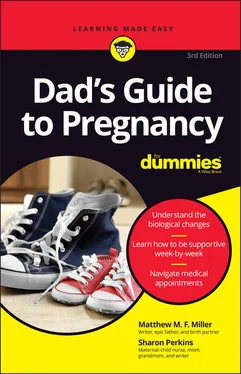Sharon Perkins - Dad's Guide to Pregnancy For Dummies
Здесь есть возможность читать онлайн «Sharon Perkins - Dad's Guide to Pregnancy For Dummies» — ознакомительный отрывок электронной книги совершенно бесплатно, а после прочтения отрывка купить полную версию. В некоторых случаях можно слушать аудио, скачать через торрент в формате fb2 и присутствует краткое содержание. Жанр: unrecognised, на английском языке. Описание произведения, (предисловие) а так же отзывы посетителей доступны на портале библиотеки ЛибКат.
- Название:Dad's Guide to Pregnancy For Dummies
- Автор:
- Жанр:
- Год:неизвестен
- ISBN:нет данных
- Рейтинг книги:5 / 5. Голосов: 1
-
Избранное:Добавить в избранное
- Отзывы:
-
Ваша оценка:
- 100
- 1
- 2
- 3
- 4
- 5
Dad's Guide to Pregnancy For Dummies: краткое содержание, описание и аннотация
Предлагаем к чтению аннотацию, описание, краткое содержание или предисловие (зависит от того, что написал сам автор книги «Dad's Guide to Pregnancy For Dummies»). Если вы не нашли необходимую информацию о книге — напишите в комментариях, мы постараемся отыскать её.
Dad’s Guide to Pregnancy For Dummies
Dad’s Guide to Pregnancy For Dummies
Dad's Guide to Pregnancy For Dummies — читать онлайн ознакомительный отрывок
Ниже представлен текст книги, разбитый по страницам. Система сохранения места последней прочитанной страницы, позволяет с удобством читать онлайн бесплатно книгу «Dad's Guide to Pregnancy For Dummies», без необходимости каждый раз заново искать на чём Вы остановились. Поставьте закладку, и сможете в любой момент перейти на страницу, на которой закончили чтение.
Интервал:
Закладка:
Checking on potential problems when nothing’s happening
For many couples, the first step toward fixing infertility is admitting that you’re having a problem. It’s not an easy revelation to make because it means that at some basic level, your bodies are failing you. Fertility problems aren’t fair, they’re not fun, and they can be cause for a wide array of emotions, frustrations, and outright anger.
The good news is that this is an age in which getting pregnant doesn’t have to be a simple matter of the birds and the bees. Throw in a doctor or two, and you may be well on your way to conceiving in no time flat.
If you’re not getting pregnant after a few months, especially if your partner is older than 35, it’s time to check things out — for both of you. For her, this may involve the following tests:
Blood tests: These check hormone levels, including follicle stimulating hormone, or FSH. FSH levels are normally below 9 mIU/ml on day two or three of the menstrual cycle; higher levels indicate decreased ovarian reserve and the possible need for medical intervention.
Hysterosalpingogram (HSG): This test injects dye into the uterus through a catheter placed through the cervix. The dye outlines the shape of the uterus and fallopian tubes. HSG can identify blockages in or dilation of the fallopian tubes that interferes with embryo transport, and it also shows fibroids and polyps in the uterus, which may interfere with implantation.
Hysteroscopy: This test uses a hysteroscope, a sort of mini-telescope, to evaluate the uterus for fibroids or polyps. Small fibroids and polyps can also be removed at the time of the test.
For you, it’s a quick trip to the urologist for a full physical, blood work, and a semen analysis. This is the only way you can find out your sperm count and the quality and motility of your sperm.
Semen collection at a medical center is just as uncomfortable as it sounds, but it must be done. Just keep your expectations to a minimum and forget all those movie scenes showing posh rooms, dirty magazines, and absolute privacy. If you have to produce in the doctor’s office or a hospital lab, you may very well find yourself in a bathroom, unable to escape the distractions of screaming children and the witty banter of the nursing staff outside the door.
 Some offices allow specimens to be collected in the privacy of your home and then delivered to the lab within an hour. Ask your doctor about this alternative, as well as any special instructions for collection and transportation.
Some offices allow specimens to be collected in the privacy of your home and then delivered to the lab within an hour. Ask your doctor about this alternative, as well as any special instructions for collection and transportation.
Working through it when your partner needs treatment
Some female fertility issues are easily dealt with by simply taking a pill that induces ovulation. But female infertility can also lead to daily injections of fertility medications, uncomfortable vaginal ultrasounds to assess egg development, painful surgeries to remove fibroids or repair damaged fallopian tubes, and frequent blood tests.
Fixing female fertility issues can be a drawn-out affair that combines inconvenient and uncomfortable procedures with medications that manipulate hormones, a difficult combination if there ever was one. And if your partner suddenly views childbearing as a woman’s most important prerogative, her seeming inability to accomplish it and subsequent emotions can make fertility treatment a tough time for both of you.
 Even though you may have your own stresses when dealing with fertility issues, remember that at least you aren’t dealing with a barrage of excess hormones, and keep your cool if conversations get complicated.
Even though you may have your own stresses when dealing with fertility issues, remember that at least you aren’t dealing with a barrage of excess hormones, and keep your cool if conversations get complicated.
Exploring solutions when your sperm don’t stack up
A count of less than 20 million is considered a low sperm count. Although that may sound like a large number, due to the number of abnormal sperm in the normal sample and the distance required to reach the egg, it takes a lot of good sperm to achieve conception.
 Sperm is produced on a cycle, so the semen you produce now actually was created three months ago. If your sperm count is low, start thinking back to what was going on three months prior. An illness, medications, or a hot-tub vacation may be the culprit.
Sperm is produced on a cycle, so the semen you produce now actually was created three months ago. If your sperm count is low, start thinking back to what was going on three months prior. An illness, medications, or a hot-tub vacation may be the culprit.
Learning the components
What exactly makes a semen specimen normal? The following guidelines from the World Health Organization (WHO) are deemed the ideal for baby making:
Volume: About 1.5 to 5 milliliters of semen should be present in a single ejaculate, equaling about a teaspoon.
Concentration: Strength in numbers is key. You need at least 20 million sperm per milliliter of ejaculate to hit the normal range.
Motility: For every man, an average ejaculate contains dead, slow, and immobile sperm. However, at least 40 percent of your sperm in a single sample should be moving.
Morphology: Shape is also important to reproduction, and the lab technician examining your sample takes a close look at how many of your swimmers are normally shaped. A normal amount of normally shaped sperm is considered to be anything above 30 percent.
Trajectory: Graded on a 4-point scale, this test determines how many of your sperm are moving forward. A normal score is 2+.
White blood cells: Too many white blood cells can indicate an infection in your groin. A passing grade is no more than 0 to 5 per power field.
Hyperviscosity: Your semen sample should liquefy within 30 minutes after ejaculation. If it takes longer, it reduces the chances for sperm to swim before being expelled from the vagina.
pH: Like an AA battery, your semen needs to be alkaline to avoid making the vagina too acidic and, ultimately, killing the sperm.
A semen analysis also evaluates the following:
Head quality: The head of the sperm contains all the genetic material, so if the head is misshapen, it won’t be capable of fertilizing an egg.
Midsection malaise: Believe it or not, this part of your sperm contains fructose, which gives your sperm energy to swim. If the levels are low, it can account for slow swimmers.
Tail troubles: Much like a fish, a good tail is required for the sperm to swim forward. If too many of your sperm have no tail, multiple tails, or tails that are coiled or kinked, they won’t reach their destination.
 A low sperm count may have you feeling, well, downright low. Feeling embarrassed is completely natural but also completely unnecessary. Infertility has no correlation to a man’s masculinity, nor does it have anything to do with the size of his penis. Having a low sperm count is no different from having asthma — it’s a medical condition that requires treatment.
A low sperm count may have you feeling, well, downright low. Feeling embarrassed is completely natural but also completely unnecessary. Infertility has no correlation to a man’s masculinity, nor does it have anything to do with the size of his penis. Having a low sperm count is no different from having asthma — it’s a medical condition that requires treatment.
 Because sperm counts are created months out, you need to have a follow-up semen analysis to see whether the issue is corrected by lifestyle changes. Although you won’t be in a rush to do it all again anytime soon, whether your results are good or bad, schedule a follow-up analysis four to six weeks after the first one to get a better, more complete picture.
Because sperm counts are created months out, you need to have a follow-up semen analysis to see whether the issue is corrected by lifestyle changes. Although you won’t be in a rush to do it all again anytime soon, whether your results are good or bad, schedule a follow-up analysis four to six weeks after the first one to get a better, more complete picture.
Интервал:
Закладка:
Похожие книги на «Dad's Guide to Pregnancy For Dummies»
Представляем Вашему вниманию похожие книги на «Dad's Guide to Pregnancy For Dummies» списком для выбора. Мы отобрали схожую по названию и смыслу литературу в надежде предоставить читателям больше вариантов отыскать новые, интересные, ещё непрочитанные произведения.
Обсуждение, отзывы о книге «Dad's Guide to Pregnancy For Dummies» и просто собственные мнения читателей. Оставьте ваши комментарии, напишите, что Вы думаете о произведении, его смысле или главных героях. Укажите что конкретно понравилось, а что нет, и почему Вы так считаете.












